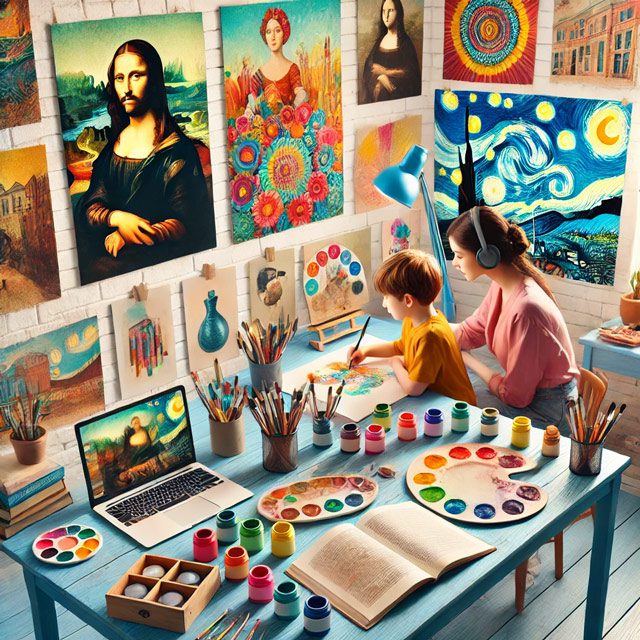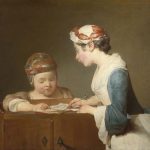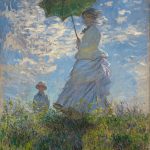
Incorporating art history into your homeschool curriculum may seem like an overwhelming task. Maybe you’re not an art expert, or you think it’s too time-consuming or expensive. But here’s the truth: adding art history to your homeschooling plan is not only possible, it’s a fun and enriching experience that can benefit your child in unexpected ways. It taps into creativity, critical thinking, and cultural awareness, while enhancing your homeschool program without adding unnecessary stress. Plus, there are tons of free or low-cost resources out there to help you along the way.
Why Art History is Essential in Homeschooling
One of the strongest reasons to include art history in your homeschool curriculum is that it fosters creativity and imagination. By studying how artists have expressed themselves throughout history, children begin to see the world in different ways. This exposure helps them come up with their own creative ideas, whether they’re painting, sculpting, or even problem-solving in other subjects like math or science. Art offers a way for children to process their emotions and express themselves in ways they might not be able to with words alone.
Beyond creativity, art history is also a powerful tool for critical thinking. Analyzing a painting or sculpture involves more than just appreciating its beauty. It requires understanding the techniques used, the cultural context of the time, and the messages the artist was trying to convey. When your child learns to “read” a painting the same way they would analyze a piece of literature, they’re developing skills that go beyond art. These skills apply to history, politics, and other areas of study where interpretation and analysis are key.
Art history also broadens cultural awareness. It gives children a window into different societies, beliefs, and values from across the globe and throughout time. Studying art from different eras—whether it’s Ancient Egypt, Renaissance Italy, or contemporary America—helps children understand how different cultures express themselves and how they shape the world around them. This knowledge encourages empathy and helps your child develop a more well-rounded worldview.
Finally, art history makes learning interdisciplinary, seamlessly connecting with other subjects in your homeschool curriculum. Studying the Impressionists can tie into lessons on French history, while analyzing Roman architecture could complement a study of ancient civilizations. The flexibility of art history allows it to intersect with other subjects, making learning more dynamic and well-rounded.
Overcoming Common Homeschooling Challenges with Art History
You may be thinking, “This all sounds great, but I’m not an art expert. How can I teach art history when I barely know the difference between Monet and Manet?” It’s a common concern, but the good news is that you don’t need to be an expert to teach art history effectively. There are countless resources available online—from virtual museum tours to educational YouTube channels—that can teach your child (and you!) about the greatest works of art. The key is to approach it with curiosity and a willingness to learn alongside your child.
Another challenge homeschoolers often face is time. Adding another subject to an already packed schedule can feel like too much. But art history doesn’t have to be a major time commitment. In fact, it can be easily woven into subjects you’re already teaching. For example, when studying the Renaissance in history, you can look at the art of Leonardo da Vinci or Michelangelo. If your child is learning about ancient civilizations, why not explore the art and architecture of Ancient Greece or Rome? By integrating art history into your existing curriculum, you can enrich your child’s learning experience without adding extra hours to your day.
Cost can be another concern, but studying art history doesn’t have to be expensive. Many museums offer free virtual tours that allow you to explore their collections from the comfort of your home. The Louvre, the Met, and the British Museum all have incredible resources available online, and there are also free art history courses on platforms like Khan Academy. If you want to include hands-on projects, supplies like paints, clay, and paper are relatively inexpensive, and you can even make some projects using items you already have around the house.
How to Start Incorporating Art History into Your Curriculum
Before diving into art history, start by identifying your child’s age and skill level. For younger children, focus on introducing basic concepts like shapes, colors, and styles through fun activities. For instance, show them simple works by artists like Mondrian or Matisse and have them create their own versions using cut-out shapes or bright paints. Older children can handle more complex themes, like how Impressionism broke away from the strict rules of traditional academic painting or how Surrealism reflected the artists’ reactions to world events.
Once you’ve gauged your child’s level, choose a teaching approach that works best for your homeschool. A chronological approach might appeal to history buffs, as you can take your child through the timeline of Western art, from the cave paintings of Lascaux to contemporary installations. This method is great for showing the evolution of techniques, materials, and styles. Another option is the thematic approach, where you focus on particular themes like “portraiture” or “landscapes” and study how different artists throughout history have approached these subjects. The thematic method offers more flexibility and allows you to mix and match time periods based on your child’s interests.
Next, you’ll want to structure your lessons. This doesn’t have to be overwhelming. You can start small by dedicating one afternoon a week to art history. Begin with short lessons that introduce an artist, movement, or technique, followed by a related hands-on activity. For example, if you’re studying the Impressionists, you could look at works by Claude Monet, discuss his use of light and color, and then have your child create their own landscape painting using short, dabbing brushstrokes to mimic his style. As your child becomes more comfortable with the subject, you can expand on these lessons and explore more complex topics.
Fun, Engaging Activities to Bring Art History to Life
Hands-on activities are a fantastic way to bring art history to life. Recreating famous works not only helps your child understand different artistic techniques but also gives them the confidence to experiment with their own creativity. For example, you could study Vincent van Gogh’s “Starry Night,” discussing the swirling brushstrokes and vibrant colors, then let your child paint their version of the night sky. Another fun project might involve creating a Picasso-inspired Cubist portrait, where your child cuts out different shapes and assembles them into an abstract face.
Sculpture is another medium you can explore with your child. After studying the sculpture of Ancient Greece or the Renaissance, have your child use clay to create their version of a famous statue. It doesn’t have to be perfect—what’s important is that they engage with the materials and understand how sculptors worked with form and structure.
Field trips and virtual museum tours can make art history feel more tangible. If there’s a local gallery or museum in your area, consider taking your child on a field trip. Many museums also have free educational programs for homeschoolers. If that’s not an option, virtual museum tours can be just as engaging. Institutions like the Louvre in Paris, the Metropolitan Museum of Art in New York, and the Uffizi Gallery in Florence offer interactive online tours that allow you to “walk” through their halls and view famous works of art up close.
Incorporating technology can also make learning art history more interactive. There are numerous apps and websites designed to make art history fun for kids. For example, the Google Arts & Culture app lets you zoom in on famous paintings to see details you might miss in person, while the DailyArt app sends a daily masterpiece straight to your phone with a short description of its history and importance. YouTube channels like “Art with Mati and Dada” offer entertaining, animated videos that introduce famous artists and their works in a way that’s engaging for younger children.
Suggested Art History Resources for Homeschoolers
One of the best ways to get started with art history in your homeschool is by using quality books. “The Story of Paintings” by Mick Manning is a great resource for younger children, offering a visually rich introduction to some of the world’s most famous paintings. Another excellent option is “Art Fraud Detective” by Anna Nilsen, an interactive book where kids solve mysteries by comparing famous artworks, which helps them learn to look for details and differences between pieces.
For online resources, Khan Academy is a go-to platform. It offers free, comprehensive lessons on art history, covering a wide range of periods and movements. These lessons often include video lectures, reading materials, and quizzes, making it an easy resource to incorporate into your homeschool curriculum. If you prefer ready-made lesson plans, Teachers Pay Teachers is an online marketplace where educators sell worksheets, lesson plans, and activities focused on art history. Many of these are specifically designed for homeschoolers and can be easily integrated into your weekly routine.
In addition to books and websites, don’t overlook printables and worksheets. These are excellent for younger learners who benefit from hands-on activities. Many websites offer free coloring pages of famous works of art, which can be paired with a short lesson on the artist and the time period. You could also create a timeline of art movements, using printables to help your child visualize how different styles evolved over time.
Podcasts and audiobooks are another great way to supplement your child’s art history education. “ArtCurious” is a podcast that explores the unexpected, quirky, and mysterious aspects of art history, making it an exciting listen for older kids and teenagers. If your child enjoys listening to stories, audiobooks on famous artists or movements can offer a deeper dive into the subject.
Art History Meets STEM: Integrating Art into Science, Technology, Engineering, and Math
You might be surprised to learn that art history can easily integrate with STEM subjects, transforming them into STEAM (Science, Technology, Engineering, Arts, and Mathematics). Adding art to your science and math lessons helps children understand the world through both logical and creative lenses. For example, studying how Renaissance artists like Leonardo da Vinci used geometry in their paintings and drawings teaches children how math and art intersect. Da Vinci’s use of the “golden ratio” in his works is a perfect opportunity to discuss mathematical concepts while appreciating the beauty of the composition.
Color theory is another area where art and science meet. You can explore how artists like Claude Monet studied the effects of light on color by conducting simple experiments at home. For instance, observe how sunlight affects the way colors appear on different objects, then compare this to how Monet captured light in his paintings.
Architecture offers another connection between art and engineering. You can study famous structures like the Parthenon or the Eiffel Tower, discussing how artistic design and engineering principles work together to create functional, yet beautiful, buildings. For hands-on learners, building models of these structures using simple materials like clay or toothpicks can be an engaging way to understand the relationship between art and engineering.
Tracking Progress: Assessing Your Child’s Understanding of Art History
As you incorporate art history into your homeschool curriculum, it’s important to track your child’s progress. One way to do this is by creating a portfolio. Encourage your child to keep a record of their projects, sketches, and any written reflections they’ve done on the art they’ve studied. This portfolio not only serves as a way to assess their progress, but also gives them a sense of accomplishment as they see how much they’ve learned over time.
Another way to assess learning is through interactive quizzes and games. Art history trivia games, whether online or in a quiz format, can reinforce knowledge in a fun way. You can create flashcards with famous paintings on one side and details about the artist or movement on the other to help with memorization.
Discussion-based assessments are also a great tool for gauging understanding. Ask your child to explain their thoughts on a particular artwork. What do they like or dislike about it? What do they think the artist was trying to convey? These open-ended questions help foster critical thinking and allow you to assess their ability to interpret and analyze art.
Lastly, remember that creativity should be celebrated. While it’s important to teach art history accurately, it’s equally important to allow your child the freedom to explore and express their own artistic ideas. There’s no “right” or “wrong” way to approach art, so encourage your child to be bold and imaginative in their work.
Real-Life Success Stories: Homeschool Families Who Have Mastered Art History
Many homeschooling families have successfully incorporated art history into their curriculum, often with remarkable results. Take the example of the Smith family, who began teaching art history as part of their world history lessons. What started as a simple way to enrich their history curriculum quickly turned into one of their children’s favorite subjects. By using virtual museum tours and hands-on art projects, their kids not only gained a deeper understanding of history but also began creating their own original artwork.
Another family, the Thompsons, found that incorporating art history helped their son, who struggled with traditional academic subjects, gain confidence. By studying art movements and experimenting with different artistic techniques, he discovered a passion for painting. His portfolio became a source of pride, and his engagement in other subjects improved as he learned to approach problems creatively.
These stories show that incorporating art history can be a transformative experience in a homeschool setting. It doesn’t just teach about famous artists and movements—it gives children new ways of thinking, expressing themselves, and engaging with the world around them.
Conclusion
Incorporating art history into your homeschool curriculum offers countless benefits for your child. It nurtures creativity, sharpens critical thinking, and deepens cultural awareness. By taking advantage of free resources, creative lesson plans, and hands-on projects, you can bring the world of art history into your home in a way that’s engaging and accessible. Whether you’re a seasoned art lover or someone who’s just starting to learn about art alongside your child, there’s something for everyone in this enriching subject.
As the painter Pablo Picasso once said, “Every child is an artist. The problem is how to remain an artist once we grow up.” By introducing your child to the wonders of art history, you’re helping them tap into their natural creativity, while also giving them the tools to see the world in new and exciting ways.
Now, grab those paintbrushes and start exploring! You might just have the next great artist sitting at your kitchen table.




